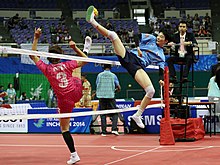
Back سيبق تكراو Arabic Takraw BAN Сепак такрау Bulgarian সেপাক টার্কো Bengali/Bangla Sepak takraw BS Sepak takraw Czech Sepak takraw Danish Sepak Takraw German Σεπάκ τακράου Greek Sepak takraw Spanish
 Women's double Sepak Takraw event at the 2014 Asian Games in Incheon | |
| Highest governing body | ISTAF |
|---|---|
| Nicknames | kick volleyball |
| Standardized | 1960, Kuala Lumpur, Malaysia |
| Clubs | 31 |
| Characteristics | |
| Contact | No |
| Team members | 2, 3, or 4 |
| Mixed-sex | No |
| Type | outdoor, indoor, beach |
| Equipment | synthetic plastic or rattan ball, net |
| Venue | Sepak Takraw court |
| Presence | |
| Country or region | Asia |
| Olympic | No |
| Paralympic | No |
| World Games | No |
Sepak takraw, or Sepaktakraw,[1] also called buka ball, kick volleyball or foot volleyball, is a team sport. It is played with a ball made of rattan or synthetic plastic between two teams of two to four players on a court resembling a badminton court.[2][3] It is similar to volleyball and footvolley in its use of a rattan ball and players using only their feet, knees, shoulders, chest and head to touch the ball. Sepak Takraw is often referred to as a mixture of volleyball, due to its use of a net, and association football, as players use their feet.[4]
The sport's modern version was introduced, developed and standardized in 1960 when officials from Malaysia, Singapore, Thailand and Myanmar met in Kuala Lumpur to agree on a name and standard rules for it.[5] It was previously known as Sepak Raga Jaring, and was first exhibited in Penang in 1945. It was introduced in the 1965 Southeast Asian Games in Kuala Lumpur as a medal event. Sepak Takraw is considered Malaysia's national sport.[1][2]
Sepak takraw is governed internationally by the International Sepaktakraw Federation (ISTAF), formed in 1988, which is responsible for major international tournaments including the ISTAF SuperSeries (ISS) and ISTAF World Cup (IWC), Malaysia's Khir Johari Cup, and Thailand's King Cup.
Sepak takraw resembles native sports known as Sepak Raga in Brunei, Indonesia, Malaysia, and Singapore; Takraw and Rago/Raga in Indonesia; Sipa in the Philippines; Chinlone in Myanmar; Takraw in Thailand; Kataw in Laos; and Sek Dai in Cambodia. It is also claimed to be related to Cuju in China, Cau May in Vietnam, Jegichagi in Korea and Kemari in Japan.
- ^ a b Victoria R. Williams (2015). Weird Sports and Wacky Games around the World: From Buzkashi to Zorbing: From Buzkashi to Zorbing. ABC-CLIO. p. 264. ISBN 9781610696401.
- ^ a b Shawn Kelley. "Takraw: A Traditional Southeast Asian Sport". Archived from the original on 10 July 2007. Retrieved 30 July 2007.
- ^ J. A. Mangan, Fan Hong (2002). Sport in Asian Society: Past and Present. Frank Cass Publishers. p. 220. ISBN 978-0-7146-8330-0.
- ^ Team, Editorial (5 November 2021). "Sepak Takraw: The History, Rules And Equipment". historyofsoccer.info. Retrieved 21 December 2021.
- ^ "Sepaktakraw". Olympic Council of Asia. Retrieved 10 July 2021.
© MMXXIII Rich X Search. We shall prevail. All rights reserved. Rich X Search